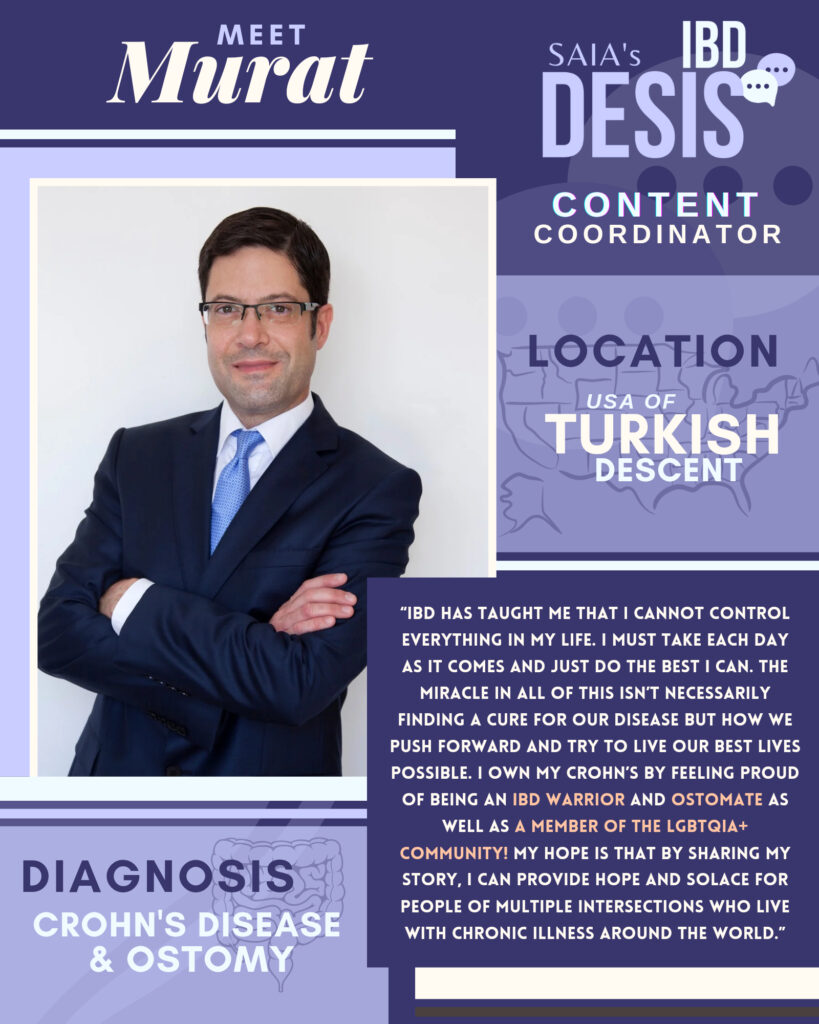
Written by Murat Kavlak
My name is Murat Kavlak and I’m a Turkish-American male living with IBD for 28 years. I was born, raised, and educated in the U.S. and currently live in Western Massachusetts.
I was initially diagnosed with Ulcerative Colitis (UC), a form of inflammatory bowel disease (IBD), in January 1996. I had undergone my first sigmoidoscopy (of many) after a month of uncontrolled rectal bleeding. I remember that experience vividly. I was awake and lying on the table on my left side with my slacks and underwear dropped to my ankles. A few minutes after my doctor inserted the endoscope, I remembered her exact words – “…Oh, sh*t!” I was a bit stunned as I had no idea what was coming next.
After the procedure, I got dressed and waited in the exam room for my doctor to come in and explain her findings. She walked in, sat down and proceeded to explain to me that it looked like Ulcerative Colitis; however, pathology testing would confirm the findings. She then explained to me what UC was and went on to further mention that in worst case scenarios, people sometimes ended up with “bags” for the rest of their lives but that this would NEVER happen to me.
I had this bizarre visual in my mind of a person carrying a large plastic bag with a handle in one hand that was somehow connected to their body (somewhere but no idea where exactly) via a thick flexible plastic hose of some kind and that their poop filled up in this bag. I tried to imagine how anyone could manage to go about their day while having to carry this cumbersome plastic bag in one hand 24/7. The entire concept was extremely abstract in my mind.
As the months (and my symptoms) progressed over the coming year with one constant flare-up that did not respond to any treatments, I began to see that picture in my mind become more defined and clear. I felt this sense of foreboding and apprehension set in as the dark clouds that were just over the horizon began heading my way.
On March 7th, 1997, I had my first ileal pouch anastomosis (IPAA or j-pouch) surgery, done in one-stage. This meant that I did not have a temporary ileostomy as done in staged operations. I remember having to prepare for my surgery the day before. I could not eat anything solid and had to take a total of 16 antibiotic horse pills along with the most disgusting bowel prep a pharmaceutical company could ever create – PhosphoSoda. The drink was so horrendous tasting that it caused me to vomit the first 8 antibiotic tablets I had to ingest. Somehow, I managed to finish my prep and take the remaining 8 antibiotic tablets without further vomiting. I felt like a shadow of myself – feeling terribly weak from not eating all day, feeling very sick with active disease and rectal bleeding, and feeling the mental health trauma of trying to ingest all those pills and drink the horrendous bowel prep. What kept me going was the hope that all of this would be worth it in the end.
My surgery lasted 6-7 hours. I was expecting to wake up with a temporary ileostomy; however, during the procedure, my surgeon decided that my body would be able to physically handle a one-stage surgery. As I was waking up in recovery, my mom was screaming with excitement that I did not have an ileostomy. My eyes shot wide open! My immediate thought was, “Oh, my God!…They didn’t do the surgery!…I went through that horrible prep and they didn’t do the surgery!” As I began to wake up some more and obtained some semblance of intelligible comprehension of my immediate surroundings, I eventually understood that I did have my surgery and that it was done in one stage. I was all done!
I spent seven days in the hospital (and “celebrated” my birthday in the hospital). The day after surgery, I was curious how my abdomen looked. I lifted up my hospital gown and just stared at all the surgical staples running down my mid abdomen. I burst out crying at what I saw. On an emotional level, I felt like I was somehow “butchered” and the thought of someone having their hands inside my abdominal cavity and then removing something from inside me scared me and grossed me out at the same time. I couldn’t shake this feeling of being violated by this surgery. I felt better after having a good cry and realized that I was probably mourning the loss of my colon.
Life with a J-Pouch
For the next 11 years, I had a fairly “normal” life. I didn’t have any major complications or issues related to my j-pouch. After I made a full recovery, I averaged seven to eight trips to the bathroom during the day and once or twice at night. I did not have any issues with daytime or nighttime leakage and nothing major when it came to perianal skin irritation.
In mid-2008, I began experiencing what I thought was perianal skin irritation. I continued my regular routine of maintaining excellent hygiene and using skin protectant creams; however, this time, none of it seemed to help. After my symptoms progressively worsened, I went to see my local colorectal surgeon who examined me and said it looked like a bacterial infection and placed me on oral antibiotics for two weeks.
After a week of treatment, and with worsening symptoms, I went back to see him. This time, he said it must then be a fungal infection and placed me on oral and topical antifungal medications. Another week passed with no resolution at all and now with extremely raw red and irritated skin! I went back to my doctor again and he was simply at a loss for how to help me. Out of desperation, I went to see my primary care doctor to see if he could somehow help. He examined me and was mortified at what he saw. He said it looked like someone took the most abrasive sandpaper available and aggressively rubbed it all over my bottom. He had never seen anything like it before! The only thing he could think of was to refer me to a dermatologist.
The dermatologist examined me and felt the only possibility that came to his mind was perhaps that it might be herpes!….”ARE YOU KIDDING ME?!?!?!…That’s IMPOSSIBLE,” I said. “I’ve NEVER engaged in any kind of sexual activity that would cause me to contract herpes!!!” Regardless, the doctor took a tissue biopsy and sent it off to pathology. Sure enough, the results did NOT indicate herpes or any other kind of STD.
The Plot Thickens
Seemingly running into a dead-end as to how to resolve this, I ended up going back to Boston and seeing my original colorectal surgeon. One of the first questions he asked me was whether or not anyone did any kind of endoscopic exam on me while I was going from doctor to doctor in Washington, D.C. I told him, “no,” and that the last time I had such an exam was about a year ago. I was prepped for a pouchoscopy during this visit and was awake for the procedure. I watched the video monitor as the endoscope passed into my j-pouch. I was absolutely stunned to see that my entire j-pouch was completely full of ulcers! Why did I not feel any internal pain (cramping) or have any diarrhea all this time?? Based on what my ulcerated j-pouch and perianal region looked like, I was now given a new diagnosis: “Crohn’s Pouchitis and Perianal Crohn’s.” Pathology results confirmed this to be the case.
After this visit, I was immediately placed on a Prednisone taper, Ciprofloxacin, and Flagyl. Unfortunately, I did not achieve much of a response. After a month of symptoms being unresponsive to this combination of medications, my gastroenterologist informed me that I could now start one of a few biologics available. I asked him which one would, in theory, provide the fastest response and how long could that response take. He told me that Infliximab was the best option and, if it worked, I should see improvement in about four weeks. Otherwise, my only other option was j-pouch removal and to have a permanent end ileostomy.
Finally, in September 2008, I began receiving my first Infliximab infusions and hoped for the best! As predicted, by the fourth week, I began seeing noticeable improvement with my symptoms! Yaaaay!!!! I was finally on the mend! Life was good for the next two years during which time I achieved remission and returned to feeling like myself again.
The Return of Crohn’s
Unfortunately, in early 2011, my perianal disease symptoms began returning. I immediately recognized what was happening. It seemed I was no longer responding to Infliximab. My doctor switched me over to Adalimumab, however that had absolutely no effect.
At this point, my doctors told me my only other option remaining was j-pouch removal and formation of an end ileostomy. This absolutely terrified me! Up to this point, I never had an ileostomy in my life so I didn’t have any experience on which to base my judgment. My former primary care doctor’s words, who diagnosed me with UC in 1996, came back to haunt me.
In late 2011, desperate to avoid permanent ileostomy surgery, I moved from the U.S. to Istanbul, Turkey, where I underwent three protocol treatments of Leukocytaphersis (removal of excess white blood cells) over a two-year period. Although these experimental treatments helped to a point, my symptoms never completely went away.
In mid-2013, I underwent a series of tests at the Cleveland Clinic to discover that my j-pouch and other segments of small bowel loops were severely deformed and I was headed for j-pouch failure. In November of that year, I underwent loop ileostomy surgery to have my first ostomy. After a year-and-a-half, I decided to have my second j-pouch surgery (redo j-pouch). Even with a redone j-pouch, things never functioned properly and my quality of life was poor. In mid-2018, further testing indicated my new j-pouch and surrounding small bowel loops were undergoing the same deformities I experienced with the first j-pouch.
Moving Beyond the J-Pouch
In November 2018, I made the decision to have permanent end ileostomy surgery and had my redone j-pouch excised. Since then, my quality of life has been much better. I am currently dealing with chronic SIBO (Small Intestine Bacterial Overgrowth) and SIFO (Small Intestine Fungal Overgrowth), which tends to happen in folks who have small bowel angulations as a result of numerous abdominal surgeries.
Over the years, this disease has taught me that I cannot control everything in my life. I must take each day as it comes and just do the best I can. The miracle in all of this isn’t necessarily finding a cure for our disease but how we push forward and try to live our best lives possible.
I own my Crohn’s by feeling proud of being an IBD warrior and ostomate as well as a member of the LGBTQIA+ Community! My hope is that by sharing my story, I can provide hope and solace for people of multiple intersections who live with chronic illness around the world.
